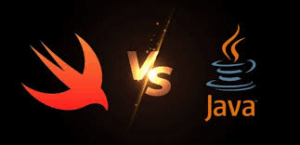As we move towards 2025, the world of software development is evolving. Java and Swift, two of the most prominent programming languages, remain in the driver’s seat of most developers’ careers. However, with the world of technology constantly changing, which of them do you focus on in the coming year? In this post, we’ll dive into the current trends, business requirements, and future outlooks to help you make a well-supported decision.
Java: Enterprise Backbone
Java has been an industry standard for enterprise software development for decades. Its platform independence, vast ecosystem, and stable performance make it an enterprise-level programming language of first choice.
Why Java Is Still Here?
Enterprise Applications: Java powers most enterprise-level applications, especially in domains like finance, healthcare, and government.
Android Development: While Kotlin is gaining traction, Java remains one of the first choices for Android development.
Cross-Platform Capability: Java’s “write once, run anywhere” tradition ensures programs execute on various platforms without the necessity of rewriting.
Mature Ecosystem: With Spring and Hibernate and other similar frameworks, Java offers a rich and profound set of tools to developers.
2025 Vision:
Java continues to be a staple of backend development, with a strong hold in cloud-native applications and microservices architecture. Its stability and scalability guarantee its long-term existence within enterprise settings for the foreseeable future.
Swift: The Future of Apple Ecosystem
Swift, launched by Apple in 2014, has rapidly emerged as the language of choice for iOS, macOS, watchOS, and tvOS app development. Its syntax is contemporary, and performance optimizations make it a favorite to create high-quality apps within the Apple ecosystem.
Why Swift is Picking Up Steam?
Apple Ecosystem Integration: Swift is the language of choice for developing apps on all Apple platforms, with seamless integration and performance.
Performance and Security: Swift’s emphasis on performance and security features makes it ideal for creating strong and effective applications.
Server-Side Development: With frameworks such as Vapor, Swift is now venturing beyond mobile app development into backend services, allowing full-stack development in the Apple ecosystem.
Increased Community and Material: Apple’s ongoing patronage and increased developer community ensure that Swift is a strong and developing language.
2025 Projections:
As Apple keeps pushing the boundaries with its new devices and technologies, Swift programmers will lead the way in developing the next level of applications. The evolution of the language itself, with improvements in concurrency and data protection, puts it well ahead in the running for meeting future development requirements.
Comparative Snapshot: Java vs. Swift
| Feature | Java | Swift |
|---|---|---|
| Primary Use | Enterprise software, Android | iOS/macOS/watchOS/tvOS software |
| Performance | High, with established JVM optimizations | High, with contemporary compiler optimizations |
| Safety Features | Strong typing, exception handling | Optionals, memory safety |
| Learning Curve | Moderate to steep | Moderate |
| Community Support | Extensive, with decades of development | Growing rapidly, particularly within Apple |
| Future Prospects | Stable, with constant updates | Expanding, with Apple’s constant support |
Code Comparison: Palindrome Check
To give a better idea of how Java and Swift vary in syntax as well as style, let’s consider a simple problem: determining whether a string is a palindrome.
Java Implementation :
public class Palindrome {
public static boolean isPalindrome(String str) {
str = str.toLowerCase().replaceAll("[^a-z0-9]", "");
int left = 0, right = str.length() - 1;
while (left < right) {
if (str.charAt(left) != str.charAt(right)) {
return false;
}
left++;
right--;
}
return true;
}
public static void main(String[] args) {
String test = "A man, a plan, a canal, Panama";
System.out.println(isPalindrome(test) ? "Palindrome" : "Not a palindrome");
}
}
Explanation:
Regular Expressions: Java employs replaceAll with regular expressions to eliminate non-alphanumeric characters.
Normalization: Converts the string to lowercase and removes non-alphanumeric characters to ensure accurate comparison.
Two-pointer Technique: Compares characters from both ends towards the center, stopping early if a mismatch is found.
Efficiency: Operates in O(n) time complexity and O(1) space complexity, making it suitable for large strings.
Swift Implementation :
func isPalindrome(_ str: String) -> Bool {
let clean = str.lowercased().filter { $0.isLetter || $0.isNumber }
return clean == String(clean.reversed())
}
let test = "A man, a plan, a canal, Panama"
print(isPalindrome(test) ? "Palindrome" : "Not a palindrome")
Explanation:
String Manipulation: Swift’s filter() method is employed to discard unwanted characters.
String Reversal: The reversed() function is utilized to reverse the string.
Concise Syntax: Swift’s syntax is more expressive and concise, prioritizing readability.
Which Should You Pick?
Your choice must go hand in hand with your career aspirations and interests:
Select Java if you’re keen on backend development, enterprise applications, or Android development. Its reliability and popularity assure a consistent need for Java programmers.
Select Swift if you’re enthusiastic about the Apple platform, iOS/macOS development, or full-stack development within Apple’s ecosystem. Swift’s traction and Apple’s ingenuity present thrilling prospects for developers.
Both Java and Swift have their own special strengths and opportunities. By evaluating your career goals and the industries you would like to enter, you can make the best decision that meets your objectives. Keep in mind, the best language to learn is the one that you find most exciting and related to your passion.


